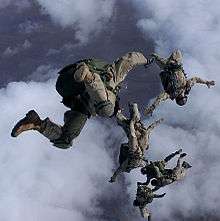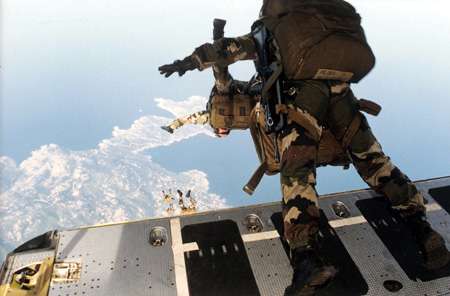High-altitude military parachuting
High-altitude military parachuting (or military free fall (MFF)) is a method of delivering military personnel, military equipment, and other military supplies from a transport aircraft at a high altitude via free-fall parachute insertion. Two techniques are used: HALO (high altitude – low opening, often called a HALO jump) and HAHO (high altitude – high opening).

In the HALO technique, the parachutist opens the parachute at a low altitude after free-falling for a period of time, while in the HAHO technique, the parachutist opens the parachute at a high altitude just a few seconds after jumping from the aircraft.
Although HALO techniques were first developed in the 1960s for military uses, in recent years HALO parachute designs have been more widely used in non-military applications, including as a form of skydiving.[1][2]
In military operations, HALO is also used for delivering equipment, supplies, or personnel, while HAHO is generally used exclusively for personnel. In typical HALO/HAHO insertions the troops jump from altitudes between 15,000 feet (4,600 m) and 35,000 feet (11,000 m).[3]
High Altitude Low Opening – HALO
The origins of the HALO technique date back to 1960 when the United States Air Force began conducting experiments that followed earlier work by Colonel John Stapp in the late 1940s[4] through early 1950s on survivability for pilots ejecting at high altitude. Stapp, a research biophysicist and medical doctor, used himself in rocket sled tests to study the effects of very high g-forces. Stapp also solved many of the problems of high-altitude flight in his earliest work for the Air Force and subjected himself to exposure to altitudes of up to 45,000 feet (14,000 m). He later helped develop pressure suits and ejection seats, which have been used in jets ever since. As part of the experiments, on August 16, 1960, Colonel Joseph Kittinger performed the first high-altitude jump at 19.5 miles (31.4 km) above the Earth's surface. Kittinger's friend and United States Naval Parachute Test Jumper Joe Crotwell was also among the consultants and test jumpers of the original program. The first time the technique was used for combat was during the Vietnam War in Laos by members of MACV-SOG. SEAL Teams of the United States Navy expanded the HALO technique to include delivery of boats and other large items.
The technique is used to airdrop supplies, equipment, or personnel at high altitudes, where aircraft can fly above surface-to-air missile (SAM) engagement levels through enemy skies without posing a threat to the transport or load. In the event that anti-aircraft cannons are active near the drop zone, the HALO technique also minimizes the parachutist's exposure to flak.
For military cargo airdrops, the rigged load is cut free and rolls out of the plane as a result of gravity. The load then proceeds to fall under canopy to a designated drop zone.
In a typical HALO exercise, the parachutist will jump from the aircraft, free-fall for a period of time at terminal velocity, and open his or her parachute at an altitude as low as 3,000 feet AGL depending on the mission. The combination of high downward speed, minimal forward airspeed, and the use of only small amounts of metal helps to defeat radar and reduces the amount of time a parachute might be visible to ground observers, enabling a stealthy insertion.
High Altitude High Opening – HAHO
The HAHO technique is used to airdrop personnel at high altitudes when aircraft are unable to fly above enemy skies without posing a threat to the jumpers. In addition, HAHO parachute jumps are employed in the covert insertion of military personnel (generally special operations forces) into enemy territory, in circumstances where the covert nature of an operation may be compromised by the loud noise of parachutes opening at low altitude.
HAHO jumps also allow a longer travel distance due to increased under-canopy time, allowing travelling distances of more than 40 miles (64 km).[5]
In a typical HAHO exercise, the jumper will jump from the aircraft and deploy the parachute at a high altitude, 10–15 seconds after the jump (typically at 27,000 feet (8,200 m) or so). The jumper will use a compass or GPS device for guidance while flying for 30 or more miles (48+ kilometres). The jumper must use way points and terrain features to navigate to their desired landing zone, and correct their course to account for changes in wind speed and direction. If deploying as a team, the team will form up in a stack while airborne with their parachutes. Usually, the jumper in the lowest position will set the travel course and act as a guide for the other team members.
Whilst in the British Special Forces (22 SAS), due to his extensive skydiving background, Charles "Nish" Bruce was pivotal in the original trials and development of the HAHO tactic now routinely used as a conflict insert for special forces.[6]
Health risks
All types of parachuting techniques are dangerous, but HALO/HAHO carry special risks. At high altitudes (greater than 22,000 feet, or 6,700 m), the partial pressure of oxygen in the Earth's atmosphere is low. Oxygen is required for human respiration and lack of pressure can lead to hypoxia. Also, rapid ascent in the jump aircraft without all nitrogen flushed from the bloodstream can lead to decompression sickness, also known as caisson disease or "the bends".
A typical HALO exercise will require a pre-breathing period (30–45 minutes) prior to jump where the jumper breathes 100% oxygen in order to flush nitrogen from their bloodstream. Also, a HALO jumper will employ an oxygen bottle during the jump. Danger can come from medical conditions affecting the jumper. For example, cigarette smoking, alcohol and drug use (including antihistamines, sedatives, and analgesics), anemia, carbon monoxide, fatigue and anxiety can all lead to a jumper being more susceptible to hypoxia. In addition, problems with the oxygen bottle and during the changeover from the pre-breather to the oxygen bottle can result in the return of nitrogen to the jumper's bloodstream and, therefore, an increased likelihood of decompression sickness. A jumper suffering from hypoxia may lose consciousness and therefore be unable to open his parachute. A jumper suffering from decompression sickness may die or become permanently disabled from nitrogen bubbles in the bloodstream, which causes inflammation of joints.
Another risk is from the low ambient temperatures prevalent at higher altitudes. At an altitude of 35,000 feet, the jumper faces temperatures of –45 °C (–50 °F), and can experience frostbite. However, HALO jumpers generally wear polypropylene knit undergarments and other warm clothing under a windproof shell to prevent this.
HALO carries the additional risk that if the parachute fails to deploy or lines become tangled, there is less time to resort to the reserve (back-up parachute) or untangle the lines.
Example of use
- The first combat high-altitude jump took place during the Vietnam War when a six-man team called SOG Recon Team Florida parachuted from 18,000 feet (5,500 m) into Laos.[7]
- In November 2001, a small team of U.S. troops from the 75th Ranger Regiment Regimental Reconnaissance Company freefall parachuted into Afghanistan in order to establish a landing strip.[8]
- In 2002, United States Air Force Pararescue jumpers conducted a HALO jump in Afghanistan as a means of reaching a gravely wounded member of the Australian Special Air Service who was stranded in a minefield.[9]
- Free fall parachute insertions were utilized during Operation Iraqi Freedom, as a means of bypassing enemy early warning systems.
- In 2009, during the rescue of Captain Richard Phillips off the coast of Somalia, a team of U.S. Navy SEALs carried out a nighttime high altitude low-opening jump into the sea in order to reach the USS Bainbridge which was towing a lifeboat containing Philips' hostage takers.[10]
- In 2012, U.S. Navy SEALs used the technique to insert into Somalia to rescue two hostages being held by pirates near the town of Adow.[11]
- Tom Cruise became the first actor to perform a HALO jump on camera for the 2018 film Mission: Impossible – Fallout.[12]
- in April 2020, military personnel from the Russian Airborne Forces, by the order of the Minister of Defence, Sergey Shoygu, performed the world's first HALO paradrop from the lower border of the Arctic stratosphere. The Russian commando group used "next-generation special-purpose parachute system", military tested oxygen equipment, navigation devices, special equipment, and uniforms while jumping from a high-flying transport plane, the Il-76 over the island of Alexandra Land located in Franz Josef Land archipelago.[13][14]
List of HALO/HAHO capable units
Notes
- "Civilian HALO Skydive from 30,000 ft. | TEEM". TEEM. 2015-06-10. Retrieved 2018-08-22.
- Taft, Jay. "Skydivers set to soar from 23,000 feet in Rochelle; unlike anywhere else in the Midwest". Rockford Register Star. Retrieved 2018-08-22.
- "High-Altitude Airdrop Missions (HAAMS) High Altitude-Low Opening (HALO) and High Altitude-High Opening (HAHO)". GlobalSecurity.org. Retrieved 2012-01-07.
- Spark, Nick T. "The Story of John Paul Stapp". The Ejection Site. Retrieved 2008-11-19.
- "Secrets of SEAL Team Six. Part 2..wmv". Retrieved 27 July 2012.
- John Geddes, Highway to Hell (An SAS Veteran's Bloody Account on the Private Army in Iraq) – Arrow Books, Random House, 2007, page 180. ISBN 9780099499466.
- Michael E. Haas (May 1998). Apollo's Warriors. DIANE Publishing. pp. 298–. ISBN 978-0-7881-4983-2.
- "RRC". Regimental Reconnaissance Company. 2001-11-21. Retrieved 2018-02-18.
- Leigh Neville (3 May 2011). Special Operations Forces in Afghanistan. Bloomsbury Publishing. pp. 83–. ISBN 978-1-84908-825-1.
- James Kitfield (25 October 2016). Twilight Warriors: The Soldiers, Spies, and Special Agents Who Are Revolutionizing the American Way of War. Basic Books. pp. 252–. ISBN 978-0-465-06470-0.
- Jessica Buchanan; Erik Landemalm; Anthony Flacco (14 May 2013). Impossible Odds: The Kidnapping of Jessica Buchanan and Her Dramatic Rescue by SEAL Team Six. Simon and Schuster. pp. 235–. ISBN 978-1-4767-2519-2.
- "Watch Tom Cruise Make History Doing a "Halo Jump" From 25,000 Feet in Mission: Impossible – Fallout". Motion Picture Association of America. 2018-06-04. Retrieved 2018-12-17.
- News, SAT World (2020-04-26). "Russian Airborne Forces World's First to Execute Paradrop From Lower Border of Arctic Stratosphere". South Africa Today. Retrieved 2020-06-09.
- Humpert, From Malte. "Russian Paratroopers Perform First-Ever High Altitude Jump Over Arctic". www.highnorthnews.com. Retrieved 2020-06-09.
References
- Black, Mike. HALO jump over Yuma Proving Ground, AZ. U.S. Marine Corps. United States of America.
- Divine, Mark (2004). Navy SEALs Air Operations – Free Fall: HALO/HAHO (used with permission). U.S. Navy SEAL 1989 to present. Founder of NavySEALs.com.
- McKenna, Pat (July 1997). A Bad Altitude. Airman Magazine. U.S. Air Force. United States of America.
- McManners, Hugh (2003), Ultimate Special Forces, pub Dorling Kindersley https://web.archive.org/web/20070927043005/http://doi.contentdirections.com/mr/dk.jsp?doi=10.1221%2F0789499738
- U.S. Army Infantry School (November 1, 1995). Lesson 3: Airlift Requests and Personnel Used in Airborne. Fundamentals of Airborne Operations, Edition B. U.S. Army Infantry School. US Army. United States of America.
- U.S. DOD (June 5, 2003). US DOD Dictionary of Military Terms: Joint Acronyms and Abbreviations. U.S. Department of Defense. United States of America.
- https://web.archive.org/web/20100106010349/http://www.airpower.maxwell.af.mil/airchronicles/aureview/1986/nov-dec/boyd.html
- http://www.globalsecurity.org/military/ops/airborne-halo-haho.htm
External links
| Wikimedia Commons has media related to High Altitude – High Opening. |
- Photo of Billy Waugh's Combat HALO Badge, etc.
- The short film STAFF FILM REPORT 66-12A (1966) is available for free download at the Internet Archive
